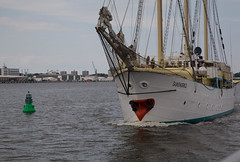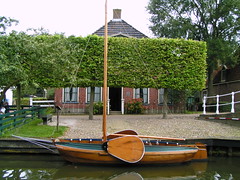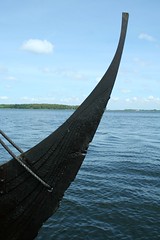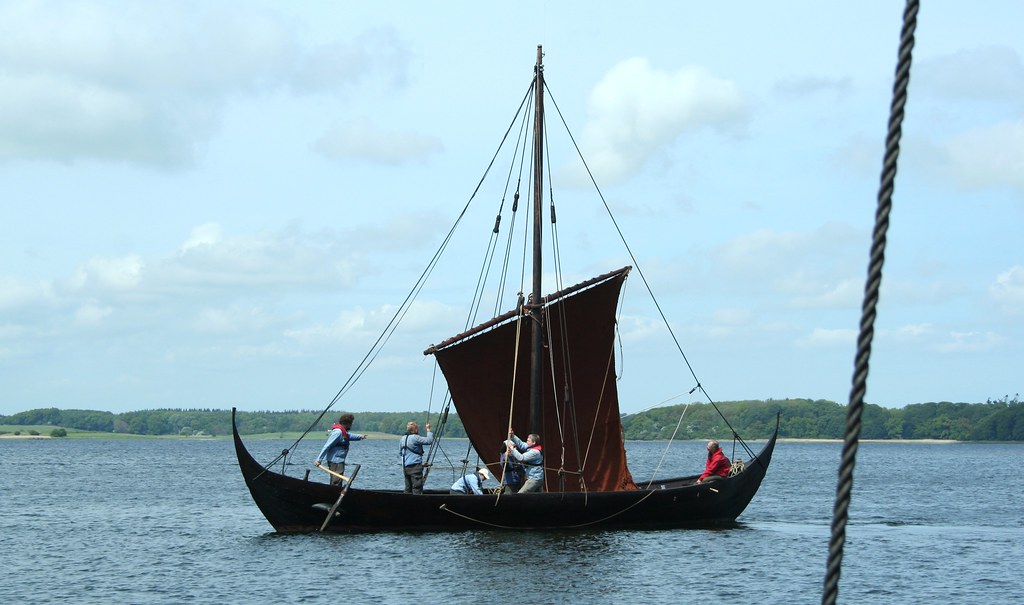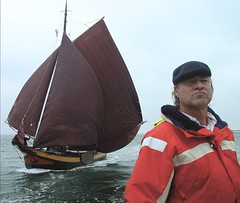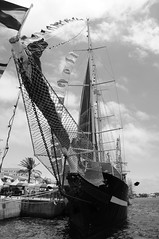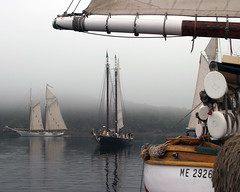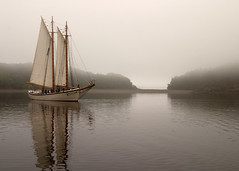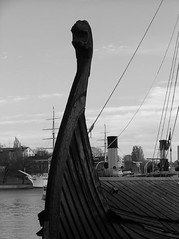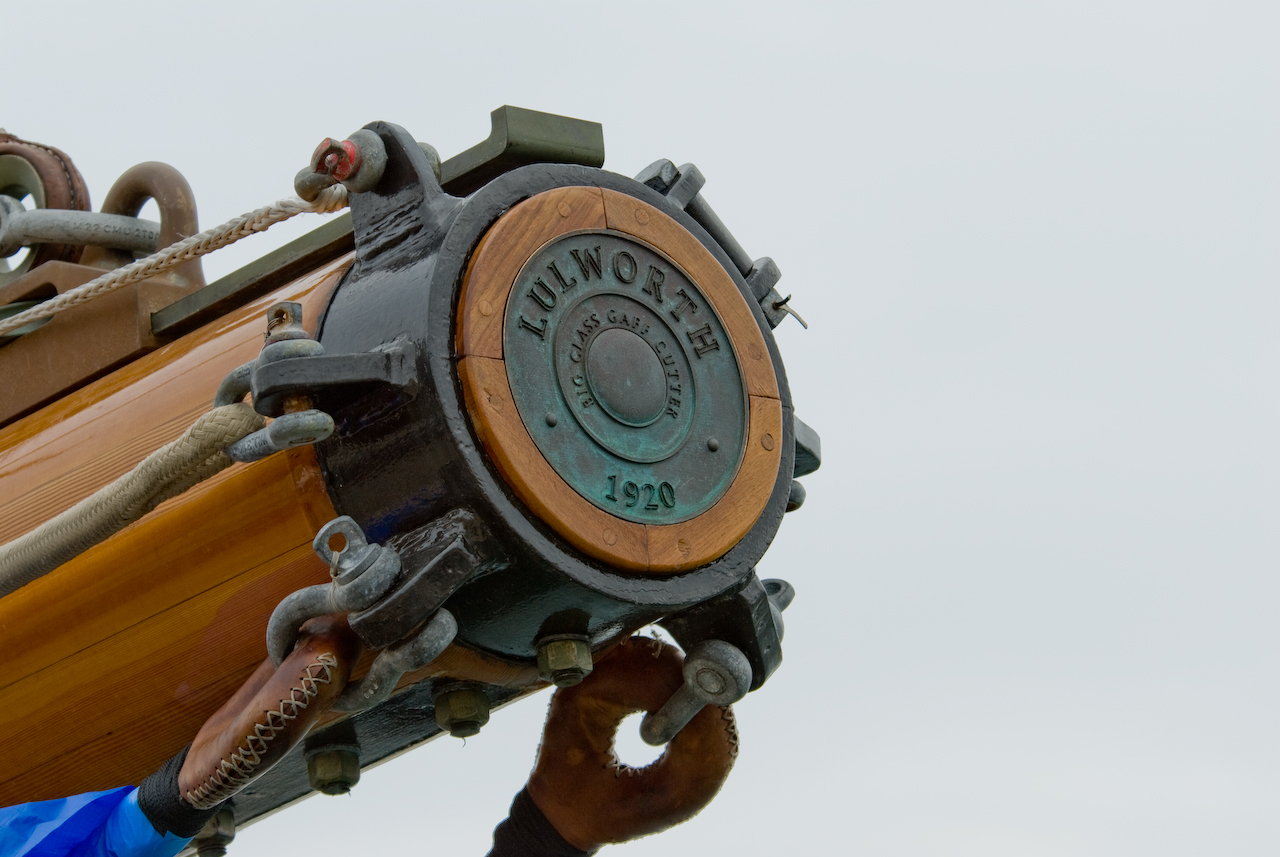20090731
Sprit of New York
20090723
Sunthorice
Length waterline 36.0 m / Beam 8.2 m / 4.7 m height / 2.8 m Draft / Displacement 407 m / 3
Data 2008:
Length waterline 42.0 m / Beam 8.2 m / 4.7 m height / Draft max. 3.50 m / 570 m displacement empty / 3,
32 m mast, sail area 800 m / 2, total length 57.0 m
Extras:
Auxiliary diesel V8 MAN 220 KVA, supplies 90 kVA Diesel Progress, auxiliary diesel Isuzu 30 kVA, 15 kVA Deutz Notdiesel.
Main Engine MWM RS 143, Built around 1942, max. 965 hp
3 x air compressors for starting 30 bar, hot steam cleaner 600 bar, dive compressor 200 bar, 1 low-pressure compressor Atlas Coopco, machine oil separator, bilge-oil separator, seawater desalination plant, UPS 20 KW three-phase current, 2 fire pumps permanently installed, 2 portable fire pumps. 1 independent bilge pump 20 kW, heating 40 kW, Hydraulikkran 3.5 tonnes
1 plasma welding machine 400 A, 1 electric welding machine 600 A, both are fixed.
5 islands a rescue 25 people, 2 board certified pharmacies, 2 x SCBA, 175 life jackets, night lights, distress rockets,
2 MOB Lanzen, life rings, 1 aluminum dinghy, unsinkable, self, length 5.2 m, 1 portable generator 220 V, 1 portable generator 24 V. 18 fire extinguishers, 3 of which are CO2, extinguishing system engine room and auxiliary diesel space CO2 Minimax, Minimax fire detection system, bilge water alarms, CO2 alarm.
2 x VHF DSC, 3 x VHF mobile, 2 x VHF GMDSS, 1x flight Icom radio, Inmarsat-C Thrane & Thrane, 2 radar transponders, Epirb 1 x, 1 x Navtex, 2 x echo sounder, 1 x magnetic compass, 1 x fluxgate compass, compass 1 x GPS, 2 x GPS, radar 48 SM, 2 navigation computer with UPS, 1 x Autopilot, 1 Kw receiver, 1 UPS for machine control, rear view camera.
For the first, 1871 on Jade designed wooden Außenjade had FS because of poor construction in a replacement contract be given. 1902 was experienced Meyer Werft Papenburg the contract for the construction of dreimastigen iron fire-ship, then the 1903 as Außenjade on the position 53 ° 52 'North and 7 ° 57 `East was set up.
The ship was built in the years 1931 / 32 modernized and extended by 5.5 meters. In addition, it received a driving machine and a Mittelklüse in the stem (Hot Lips). As a result, that the ship no longer, as hitherto before a Seitenklüse coming from the station chain is needed and thus in danger in case of bad weather situation for the ship and came chain.
On 27 October 1936 came the fire ship into an extremely dangerous situation. The days since the storm was prevailing at hurricane strength from the West. The Ebbstrom turned the ship into a bank on the lake and a aussergewöhnlch high and very heavy seas pushed the leeward totally under water. Furthermore, the Sturzsee the starboard side of the anchor capstans smashed. The vessel and crew were able only from the dangerous situation to be liberated by the anchor chain slippte. With the use of machinery and storm sails, the crew succeeded in dramatic circumstances, the ship despite heavy seas and storm on track to get to the Weser and the lighthouse Hoheweg anchoring. At the same time, capsized in the fire of the Elbe estuary ship "O` Swald mayor "and went with the whole crew lost.
During the 2nd World War, the ship's fire Aussenjade as "D" to the west of the Red Sand Lighthouse. It was on 30 March 1945 at the Spier equipment of the navy yard Wilhelm Harbor sunk by bomb hits.
After the war the ship was lifted and the Beckmann shipyard repaired. On 12 December 1951nahm ship its new space on the station P8 in the German Bight On.
On 15 November, the station canceled and the ship in the new traffic separation zone in the German Bight as
TW / Ems used.
On 13 March 1978 was the ship from service. The ship was then for 1 D-Mark at a club "sold". Various clubs and owners left the ship completely dilapidated but until then several years in the Hamburg harbor front dümpelte out. In June 2000 we bought the boat and after much work, effort and money to sail again as a three Sunthorice master.
Royal Barge
 A Royal Barge (1865), BOSCH Telecom Inside Guide to Bangkok (1995), purchased & donated by Rong Dong, digitally mastered by user:kosigrim
A Royal Barge (1865), BOSCH Telecom Inside Guide to Bangkok (1995), purchased & donated by Rong Dong, digitally mastered by user:kosigrim craftsmanship and traditional Thai art. The Royal Barge Procession takes place rarely, typically coinciding with only the most significant cultural and religious events. During the reign of King Bhumibol Adulyadej spanning over 60 years the Procession has only occurred 16 times.
craftsmanship and traditional Thai art. The Royal Barge Procession takes place rarely, typically coinciding with only the most significant cultural and religious events. During the reign of King Bhumibol Adulyadej spanning over 60 years the Procession has only occurred 16 times.The Royal Barge Procession, in the present, consists of 52 barges (51 historical Barges, and the Royal Barge the Narai Song Suban King Rama IX, built in 1994 and the only Barge built during King Bhumibol's reign) and is manned by 2,082 oarsmen. The Procession proceeds down the Chao Phraya River, from the Wasukri Royal Landing Place in Khet Dusit, Bangkok, passes the Temple of the Emerald Buddha, the The Grand Palace, Wat Po (Thai: วัดโพธิ์), and finally arrives at Wat Arun (Thai: วัดอรุณ, Temple of the Dawn).
 Thailand's Royal Barge Procession most likely began during the Ayutthaya period, in the 14th century. Western visitors witnessed and wrote about the "immense procession with 200 boats" upon their arrival in Thailand in the 18th century. During the processions, the oarsmen were kept in rhythm by the beating of drums, with accompanying music. This traditional boat song was written by Prince Dhamma Dibes of the late Ayutthaya period.
Thailand's Royal Barge Procession most likely began during the Ayutthaya period, in the 14th century. Western visitors witnessed and wrote about the "immense procession with 200 boats" upon their arrival in Thailand in the 18th century. During the processions, the oarsmen were kept in rhythm by the beating of drums, with accompanying music. This traditional boat song was written by Prince Dhamma Dibes of the late Ayutthaya period.20090722
20090721
Stern
Oops!
The klipper ran aground but came free in the next high water. The name of the ship is: Gouden Bodem, (Golden Bottom), sic!
Bietenrace 2008, finish
20090718
HMS Victory
 HMS Victory is a first rate ship of the line of the Royal Navy, started in 1759 and launched in 1765, most famous as Lord Nelson's flagship at the Battle of Trafalgar. She is the oldest naval ship still in commission, and now sits in dry dock in Portsmouth, England as a museum ship.
HMS Victory is a first rate ship of the line of the Royal Navy, started in 1759 and launched in 1765, most famous as Lord Nelson's flagship at the Battle of Trafalgar. She is the oldest naval ship still in commission, and now sits in dry dock in Portsmouth, England as a museum ship.In December 1758, the commissioner of Chatham Dockyard was instructed to prepare a dry dock for the construction of a new first-rate ship. This was an unusual occurrence at the time as the Royal Navy preferred smaller and more manoeuvrable ships, and it was unusual for more than two to be in commission simultaneously; during the whole of the 18th century only ten were constructed.
The outline plans arrived in June 1759 and were based on HMS Royal George which had been launched at Woolwich Dockyard in 1756. The naval architect chosen to design the ship was Sir Thomas Slade who, at the time, was the appointed Surveyor of the Navy. She was designed to carry at least 100 guns; in practice, her armament varied from 104 to 106 guns and carronades.
The keel was laid on 23 July 1759 in the Old Single Dock (since renamed No. 2 Dock and now Victory Dock), and the name was finally chosen in October 1760. It was to commemorate the Annus Mirabilis or Year of Victories, of 1759. In that year of the Seven Years' War, land victories had been won at Quebec, Minden and naval battles had been won at Lagos and Quiberon Bay. There were some doubts whether this was a suitable name since the previous first-rate Victory had been lost with all on board in 1744.
 50°48′06.52″N 1°06′34.5″W
50°48′06.52″N 1°06′34.5″W  Once the frame had been constructed, it was normal to cover the ship up and leave it for several months to season. However, the end of the Seven Years' War meant that she remained in this condition for nearly three years, which helped her subsequent longevity. Work restarted in autumn 1763 and she was finally launched on 7 May 1765, having cost £63,176 and 3 shillings (present day £50 million) and used around 6000 trees, 90% of which were oak and the remainder elm, pine and fir.
Once the frame had been constructed, it was normal to cover the ship up and leave it for several months to season. However, the end of the Seven Years' War meant that she remained in this condition for nearly three years, which helped her subsequent longevity. Work restarted in autumn 1763 and she was finally launched on 7 May 1765, having cost £63,176 and 3 shillings (present day £50 million) and used around 6000 trees, 90% of which were oak and the remainder elm, pine and fir.Because there was no immediate use for her, she was placed in ordinary—in reserve, roofed over, dismasted and placed under general maintenance—moored in the River Medway for 13 years until France joined the American War of Independence.
In March 1778, John Lindsay was appointed her first captain, but he was transferred to captain HMS Prince George in May 1778 when Admiral the Honorable Augustus Keppel decided to raise his flag in Victory. She was commissioned in May 1778 under the command of Rear Admiral John Campbell (1st Captain) and Captain Jonathan Faulknor (2nd Captain), with the flag of Admiral Keppel. She was armed with smooth bore, cast iron cannon thirty 32- and 42-pounders (15 and 19 kg), thirty 24-pounders (11 kg), and forty 12-pounders (5 kg). Later, she also carried two carronade guns, firing 68-lb (31 kg) round shot.
Title : HMS Victory's Bowsprit Description : This photograph of HMS Victory shows a front view after the removal of the bowsprit. The timbers supporting the heel of the bowsprit were found to be so weakened that the figurehead could be crushed. This 68 foot steel bipole weighing 10.25 was used to support the bowsprit and prevent it from resting on the figurehead. Creator : Portsmouth Royal Dockyard Historic Trust, Accession Number : 7979




20090717
Britta
 by citronsyra
by citronsyra![T/S Britta by Emely [away working].](http://farm4.static.flickr.com/3053/2736742288_99464652e9.jpg?v=0)
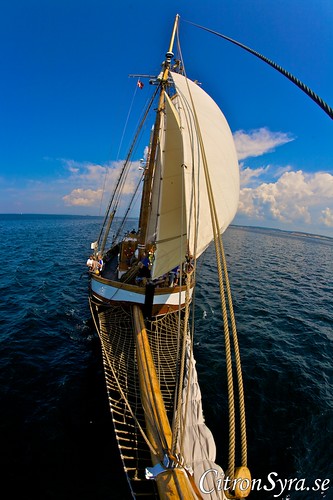

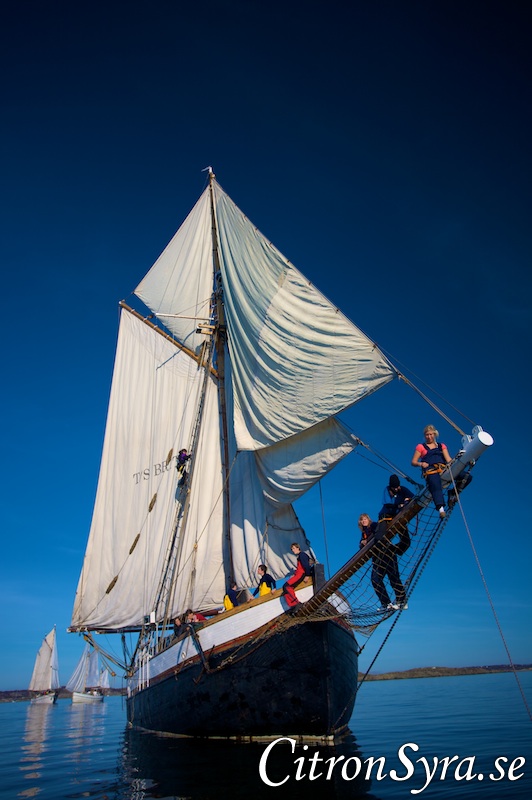
Roseway
 Roseway was built for Harold Hathaway of Taunton, Massachusetts at the John F. James & Son shipyard in Essex. Hathaway's intention was to build a boat which might best the Canadians in the international fisherman's races popular at that time; to that end, Roseway was impeccably maintained and used only occasionally as a fishing boat.
Roseway was built for Harold Hathaway of Taunton, Massachusetts at the John F. James & Son shipyard in Essex. Hathaway's intention was to build a boat which might best the Canadians in the international fisherman's races popular at that time; to that end, Roseway was impeccably maintained and used only occasionally as a fishing boat.In 1941, Roseway was purchased by the Boston Pilot's Association to serve as a pilot boat for Boston Harbor. Following the attack on Pearl Harbor later that year, mines and anti-submarine netting were installed to protect the Port of Boston, and all lighted navigational aids were extinguished. Roseway was fitted with a .50 caliber machine gun and continued her piloting duties in this challenging environment, for which service her pilots were awarded a bronze plaque from the Coast Guard at the end of the war.
Roseway continued to serve as a pilot vessel until the early 1970s, at which point she and San Francisco's Zodiac were the only pilot schooners still in service in the United States. She was then sold and converted into a passenger vessel for the tourist trade. Roseway changed hands several times in the ensuing decades, operating primarily out of Camden, Maine and the US Virgin Islands. In 1997, she was listed as a National Historic Landmark. Roseway, at that time, retained between eighty and ninety percent of her original hull fabric and was badly in need of repairs. She remained docked in Rockland, Maine until she was repossessed by the First National Bank of Damariscotta, which in 2002 donated the vessel to the newly founded World Ocean School.
Following two years of restoration in Boothbay Harbor, Roseway again set sail in 2005. She currently serves as the platform for the World Ocean School, which offers various educational programs in St. Croix and the northeastern United States.
20090716
20090715
Manouvers
20090713
Carlotta 1937

As work progressed there was some difficulty in getting Lloyd's to perform a scheduled survey of the boat going together. The Cumberland Sea Fishery wanted someone to report frequently on the progress of the yard and the task was given to a Mr.E Brinkworth - a retired Pilot who worked as the Dockmaster in Gloucester. On November 15, 1899 the boat was launched and Christened The Solway. It measured 50' long on deck, 13' beam, 8' draft and 28 Tons.
20090706
Tall Ships - Lady Washington and Moon (aka Interceptor from Pirates of the Caribbean)

Tall Ships - Lady Washington and Moon (aka Interceptor from Pirates of the Caribbean)
Originally uploaded by Darvin Atkeson
her. She was docked at Humphries Restaurant on
the Sacramento River Delta in Antioch. Humphries was named for the whale
that swam up the delta. The food isn't bad but is a tad expensive for what
it is. The restaurant does have a good view of the Delta.
The ship is a remake of the original Lady Washington which was a 90 ton
merchant sloop which sailed around Cape Horn. This replica was built in
1989 and is the official ship of Washington state. If you have a mind to
you can sign on to her crew for up to several months. From what I hear, you
pay some and you have to carry your weight or walk the plank. Some
vacation. Much shorter tours of duty are also available to those willing
to try their hand at an old profession. And if you want for around $50 you
can take a 3 hour tour. We got to go down in her hull and I was shocked by
the cramped spaces. She wasn't much bigger inside than a small RV but then
we didn't get to see the whole ship. This version does have a contemporary
motor. She was also used in the Star Trek Generations movie at the
beginning of the movie. Both movies make her look much larger than she
really is. No matter, she is more graceful on the water than many ships.
She often sails with the Hawaiian Chieftain up and down the Pacific Coast.
You can view her schedule at www.ladywashington.org
-Darv
LiquidMoonlight.com
© Darvin Atkeson
20090701
Shamrock
 Photo date: June 14, 1892. by John S. Johnston
Photo date: June 14, 1892. by John S. JohnstonAlthough there were five versions of Shamrock (numbered I through V), Johnston only lived long enough to photograph the first Shamrock, now referred to as Shamrock I. Indeed, it was during the 1899 America's Cup race between Shamrock and Columbia that Johnston reportedly caught the cold which led to his death.
(Note that there was another yacht named Shamrock - according to the August 1896 issue of Outing magazine, there was a Shamrock owned by W. P. Ward. Does anyone know anything about this vessel?)
| Type | Gaff-rigged cutter |
|---|---|
| Class | 1883 Seawanhaka 90' Rule |
| Design | William Fife, Jr. (1898) |
| Shipyard | J. Thorneycroft & Co. |
| Dimensions | LOA 38.86m LWL 25.12m Beam 7.46m Draught 6.15m |
| Displacement | 156.9 metric tonnes |
| Rig | Lower-Mast 29.56m Top-Mast 18.90m Boom 32.61m Bowsprit 8.60m Sail Area 1214.30m² |
Shamrock was the unsuccessful Irish challenger for the 10th America's Cup in 1899 to the US defender, Columbia. Shamrock was designed by William Fife III, Jr. and built in 1898 by Builder: J. Thorneycroft & Co, at Millwall on the Thames near London, England for owner Sir Thomas Lipton (of Lipton Tea Fame).
According to Americascup.com :
"Shamrock I is launched on June 24, 1899 and christened by Lady Russell of Killowen. Its build has been shrouded by secrecy and its hull is hidden by canvas, as was the case forThistle, in 1887. The 1895 challenger Valkyrie III is refitted to be sailed as a trial horse for Shamrock I. Soon after its launch, Shamrock I races against the Prince of Wales' yacht,Britannia. The Irish challenger outpaces the royal yacht in two regattas on the Solent. Shamrock I arrives in New York on August 18, 1899, and sails daily to train the crew for the Cup races.
"During the second [cup] race, on the first windward leg, Shamrock's topmast snaps and the challenger withdraws. The same evening a new spar is fitted. The Irishmen add four tonnes of ballast, so the yacht is re-measured on October 18, but its sailing performance is not improved. The Irish yacht's Steel mast is too bendy. During the 1899 yachting season, the boat goes through six sets of sails.
"On November 2, 1899, Shamrock I leaves New York and is towed back to Great Britain by Lipton's steam yacht, Erin, via the Azores. It is dry-docked on arrival. [In] 1901Shamrock I is refitted by Lipton and sails as a trial horse for his new challenger, Shamrock II, a George L. Watson design. [In April] 1903, Shamrock I is refitted again and sails as a trial horse for
Shamrock III. On May 28, 1903, with 41 crewmen onboard, Shamrock I sails to New York and races against Shamrock III before the Cup. After the Cup, Lipton tries to sell his two yachts, without success. [In] 1914 Shamrock I sails against Shamrock IV off Cowes before Lipton's fourth challenger sails across the Atlantic.
"Yacht club: Royal Ulster Yacht Club, Ireland
Sailmaker: Ratsey, Cowes
Skipper: Captain Archibald "Archie" Hogarth and his assistant, Captain Robert "Bob" Wringe
Afterguard: Jesse Connell and Captain Ben Parker "
 Shamrock (also known as Shamrock I, to distinguish it from its successors) was built in 1898 under a shroud of secrecy, and christened by Lady Russell of Killowen at its launch on June 24, 1899.
Shamrock (also known as Shamrock I, to distinguish it from its successors) was built in 1898 under a shroud of secrecy, and christened by Lady Russell of Killowen at its launch on June 24, 1899.During its trials it raced against the 1895 America's Cup challenger, Valkyrie III, as well as twice beating His Majesty's Yacht Britannia in regattas on the Solent. It sailed to New York for the America's Cup race in the summer of 1899. The Cup defender Columbia beat Shamrock in all three races. It returned to Britain in the autumn of 1899, towed by Lipton's steam yacht, Erin. It was subsequently refitted by Lipton and used as a "trial horse" to test the later challengers, Shamrock II, III, and IV.



